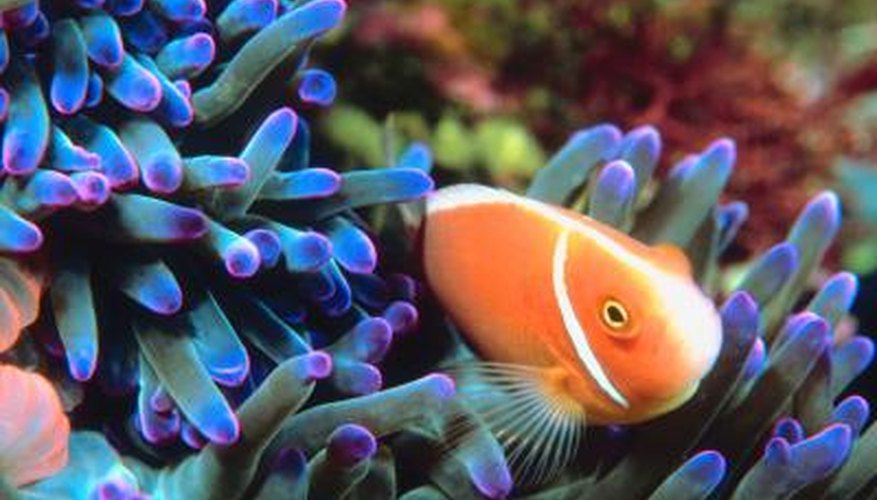Clownfish are attractive little coral fish which live among the stinging tentacles of a sea anemone. Clownfish are able to change their sex and this adaptation allows these reef fish to spawn without waiting for a mate of the appropriate sex to arrive at the anemone. The ability to change sex also means that individual fish do not need to leave the protection of their anemone to search for a mate.
Protection from Anemones
Clownfish have developed a mutualistic association with sea anemones. By briefly brushing against the stinging tentacles of this jellylike creature, these fish develop a protective mucous layer, which prevents them from being killed by the anemone. The clownfish is typically stung before it is fully acclimated to the anemone, which results in the fish developing the protective mucous layer; that layer disappears if the fish is separated from the host anemone for extended periods of time. Once acclimated though, the clownfish is afforded protection by the anemone. Due to its dependence on a host anemone, clownfish are required to live on those areas of the reef where anemones are found.
- Clownfish have developed a mutualistic association with sea anemones.
- By briefly brushing against the stinging tentacles of this jellylike creature, these fish develop a protective mucous layer, which prevents them from being killed by the anemone.
Protection for Eggs
Clownfish actively choose to lay their eggs as close to their host anemone as possible. The presence of the anemone, with its stinging tentacles, protects the developing eggs from predators, while the male clownfish tends to the nest, by fanning the eggs and removing those that have died. The male fish uses his pectoral or side fins to circulate oxygenated water over the eggs, and removes detritus and debris from the eggs by taking them into his mouth.
Sex Change
Clownfish hatch with both male and female sex organs. The largest and most dominant juvenile clownfish will develop into a female, while the second largest fish develops into a functional male. Male fish can change sex and become females and do so if the female dies, but female clownfish cannot change its sex back to a male.
Locating an Anemone
Clownfish larvae hatch at night and swim up to the surface water, where they join other plankton organisms. This larval stage ends when the tiny fish settles to the sea floor after approximately eight days. At this stage, the young clownfish must locate an anemone as soon as possible before it becomes preyed upon. Certain clownfish species follow a scent trail that has been released by the anemone, while other species look for and locate their future host anemone by sight.
- Clownfish larvae hatch at night and swim up to the surface water, where they join other plankton organisms.
- Certain clownfish species follow a scent trail that has been released by the anemone, while other species look for and locate their future host anemone by sight.
